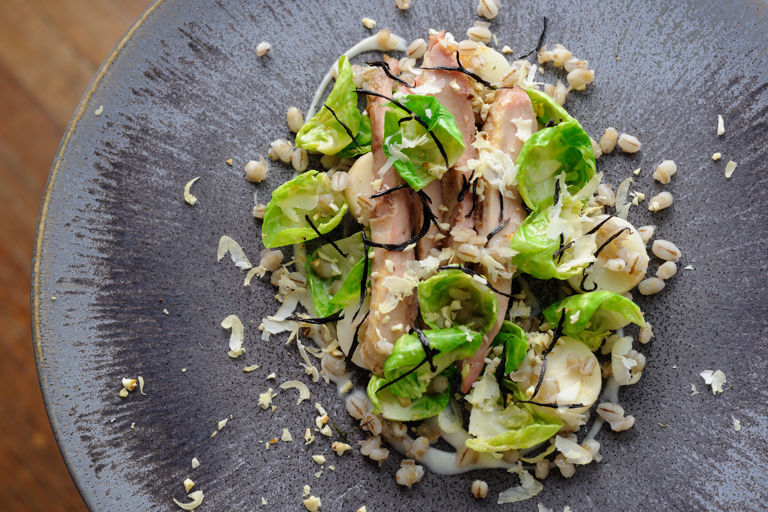Roasted partridge, hay-baked celeriac, pearl barley and sprout leaves
Item 1 of 1
- 4
- 3 hours
This roasted partridge recipe from Adam Simmonds requires cooking sous-vide, micro scales, hay and a certain degree of butchery; be prepared to work hard for this dish, it will be worth the effort.
First published in 2015
discover more:
Ingredients
Metric
Imperial
Partridge
- 4 partridges, each weighing 500g, guts in and head on
- 100ml of chicken stock, seasoned
Pearl barley
- 250g of pearl barley
- 300ml of water
- 300ml of chicken stock
- 0.5g of fresh thyme
- 1 garlic clove
- 15g of smoked bacon
- 3g of salt
Hay-baked celeriac
- 500g of celeriac
Salt crust
- 100g of hay, washed
- 500g of plain flour
- 400ml of water
- 300g of coarse sea salt
Partridge sauce
- 250g of partridge bones
- 25g of butter
- 28g of onion, finely chopped
- 14g of carrots, finely chopped
- 8g of celery stick, finely chopped
- 1/4 bay leaf
- 1/2 sprig of fresh thyme
- 1 juniper berry
- 85ml of Monbazillac
- 140ml of white chicken stock
- 65ml of brown chicken stock
- 50ml of Gewürztraminer
- 1g of redcurrant jelly
- 25g of redcurrants
- 1 knob of butter
Garnish
- 23g of butter
- 100g of sprout leaves
- 160g of trompette mushrooms
SAVE RECIPE
Equipment
- Sous vide or water bath
- 2cm cutters
- Micro scales
Method
1
To make the pearl barley, soak the barley in cold water overnight. Rinse under running water
- 250g of pearl barley
2
Bring the water and chicken stock to the boil. Add the thyme, garlic, bacon and salt. Add the barley and cook slowly until tender. Season with salt, drain and cool spread out on a tray
- 300ml of water
- 300ml of chicken stock
- 0.5g of fresh thyme
- 1 garlic clove
- 15g of smoked bacon
- 3g of salt
3
To make the salt crust, heat the oven to 180˚C/Gas mark 4. Put the hay on a heavy tray and cook in the oven for about 6 minutes to blacken it. Allow to cool
- 100g of hay
4
Cut the hay into short lengths with scissors and mix with the flour, water and salt to form a dough. Roll out to a thickness of 5mm and cut out 1 or 2 discs depending on how many celeriac you have
- 500g of plain flour
- 400ml of water
- 300g of coarse sea salt
5
To make the hay-baked celeriac, heat the oven to 220°C/Gas mark 7. Wrap the hay crust fully around each celeriac and bake them for 35 minutes
- 500g of celeriac
6
Reduce the heat after this time to 160˚C/Gas mark 3 and continue cooking for 25 minutes. Cool before cracking open the crust. Cut into 1cm slices and then cut out 4 x 2cm discs
7
Reduce the heat after this time to 160˚C/Gas mark 3 and continue cooking for 25 minutes. Cool before cracking. Cut into 1cm slices and then cut out 4 x 2cm discs
8
To make the partridge, prep the bird by first removing the legs. Remove the head from about ¾ of the way up from the body. Remove the neck and the membrane that is attached to the skin
9
Remove the wishbone. Make a slit between the top of the bird and the bottom so as to remove the guts, making sure everything is removed
10
Remove the bottom part of the carcass. Remove any remaining hairs from the bird. Seal each bird into a vac-pac bag with a 2 tablespoons of chicken stock. Chill until needed
- 100ml of chicken stock
11
Meanwhile, make the partridge sauce by browning the bones in some of the butter. Once coloured, drain in a colander. Retain ¼ of the bones to refresh the sauce at the end
- 250g of partridge bones
- 25g of butter
12
Brown the onions, carrots and celery in the remaining butter until golden brown. Add the bay leaf, thyme and juniper. Drain and add to the bones
- 28g of onion
- 14g of carrots
- 8g of celery stick
- 1/4 bay leaf
- 1/2 sprig of fresh thyme
- 1 juniper berry
13
Boil the Monbazillac for 1 ¼ minutes. Reduce the Gewürztraminer to 35ml. Bring the stocks, Gewürztraminer and ¼ of the Monbazillac to the boil. Add the bones and simmer for 20 minutes
- 75ml of Monbazillac
- 140ml of white chicken stock
- 65ml of brown chicken stock
- 50ml of Gewürztraminer
14
Pass through a fine sieve, put back in the pan and bring to boil. Reduce to a sauce consistency
15
Add the redcurrants, redcurrant jelly and the remaining bones, and bring back to the boil. Remove from the heat, taste and adjust with the remaining Monbazillac. Rest for 5 minutes then sieve
- 1g of redcurrant jelly
- 25g of redcurrants
- 10ml of Monbazillac
16
Once the sauce is completed, cook the partridge sous vide at 62˚C until the core temperature is 56˚C, which should take about 20 – 25 minutes
17
Rest for 8 – 10 minutes. Remove the partridge from the vac-pac bags, drain and fry in butter until browned all over
- 1 knob of butter
18
To make the garnish, heat 20g of butter in one pan and the rest in another. Add the sprout leaves to the first pan and the trompettes to the other. Sauté for 2-3 minutes or until cooked. Drain
- 100g of sprout leaves
- 160g of trompette mushrooms
- 23g of butter
19
Remove the partridge breast from the carcass, then trim and carve into equal slices, lengthways. Serve with the celeriac, sauce and garnish
Get in touch
Please sign in or register to send a comment to Great British Chefs.



